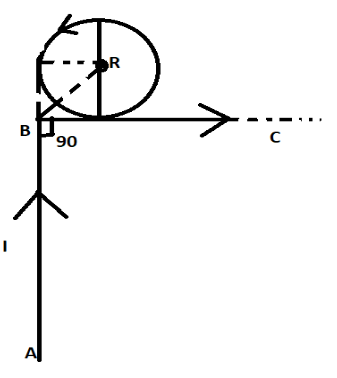Answer
384.9k+ views
Hint:In the above question, we have to find the total magnetic field. Then firstly, finding the magnetic field along the straight wire and then extending the circular loop and then again, the magnetic field of the straight wire. After adding all the magnetic fields, we got the final answer.
Complete step by step answer:
The total magnetic field will be given by adding the magnetic field of straight line and the magnetic field of the circular loop and again the magnetic field of straight line.Magnetic field can be calculated by the Biot savart’s law whose expression be given by,
$dB = \dfrac{{{\mu _0}}}{{4\pi }}\dfrac{{Idr \times r}}{{{r^3}}}$
Magnetic field of straight wire be given by the formula,
$B = \dfrac{{{\mu _0}I}}{{4\pi r}}\left( {sin{\theta _1} + \sin {\theta _2}} \right)$
where ${\theta _{1,}}{\theta _2}$ are the angles corresponding to the two ends of the wire.
Now, the magnetic field along AB,
$
{B_1} = \dfrac{{{\mu _0}I}}{{4\pi R}}\left( {sin\dfrac{\pi }{2} - \sin \dfrac{\pi }{4}} \right) \otimes \\
\Rightarrow{B_1} = \dfrac{{{\mu _0}I}}{{4\pi R}}\left( {1 - \dfrac{1}{{\sqrt 2 }}} \right) \otimes \\
$ $ \ldots \ldots \left( 1 \right)$
Now, the magnetic field along the circular loop
${B_2} = \dfrac{{{\mu _0}I}}{{2R}} \odot $ $ \ldots \ldots \left( 2 \right)$
Magnetic field along the wire BC,
$
{B_3} = \dfrac{{\mu {}_0I}}{{4\pi R}}\left( {\sin \dfrac{\pi }{2} + \sin \dfrac{\pi }{4}} \right) \odot \\
\Rightarrow{B_3} = \dfrac{{{\mu _0}I}}{{4\pi R}}\left( {1 + \dfrac{1}{{\sqrt 2 }}} \right) \odot \\
$ $ \ldots \ldots \left( 3 \right)$
Now adding all the above marked equations:
$\overrightarrow B = {B_1} + {B_2} + {B_3}$
$
\Rightarrow\overrightarrow B = \left( {\dfrac{{{\mu _0}I}}{{2R}} + \dfrac{{2{\mu _0}I}}{{4\pi R}}\dfrac{1}{{\sqrt 2 }}} \right) \odot \\
\therefore\overrightarrow B = \dfrac{{{\mu _0}I}}{{2R}}\left( {1 + \dfrac{1}{{\pi \sqrt 2 }}} \right) \odot \\ $
Hence, the correct option is B.
Note:The value of proportionality is $\dfrac{{{\mu _0}}}{{4\pi }} = {10^{ - 7}}N{A^{ - 2}}$.Biot savart law is a vector quantity which contains both magnitude and direction.$ \otimes $ is the inward direction of the field and $ \odot $ is the outward direction of the field.
Complete step by step answer:
The total magnetic field will be given by adding the magnetic field of straight line and the magnetic field of the circular loop and again the magnetic field of straight line.Magnetic field can be calculated by the Biot savart’s law whose expression be given by,
$dB = \dfrac{{{\mu _0}}}{{4\pi }}\dfrac{{Idr \times r}}{{{r^3}}}$
Magnetic field of straight wire be given by the formula,
$B = \dfrac{{{\mu _0}I}}{{4\pi r}}\left( {sin{\theta _1} + \sin {\theta _2}} \right)$
where ${\theta _{1,}}{\theta _2}$ are the angles corresponding to the two ends of the wire.
Now, the magnetic field along AB,
$
{B_1} = \dfrac{{{\mu _0}I}}{{4\pi R}}\left( {sin\dfrac{\pi }{2} - \sin \dfrac{\pi }{4}} \right) \otimes \\
\Rightarrow{B_1} = \dfrac{{{\mu _0}I}}{{4\pi R}}\left( {1 - \dfrac{1}{{\sqrt 2 }}} \right) \otimes \\
$ $ \ldots \ldots \left( 1 \right)$
Now, the magnetic field along the circular loop
${B_2} = \dfrac{{{\mu _0}I}}{{2R}} \odot $ $ \ldots \ldots \left( 2 \right)$
Magnetic field along the wire BC,
$
{B_3} = \dfrac{{\mu {}_0I}}{{4\pi R}}\left( {\sin \dfrac{\pi }{2} + \sin \dfrac{\pi }{4}} \right) \odot \\
\Rightarrow{B_3} = \dfrac{{{\mu _0}I}}{{4\pi R}}\left( {1 + \dfrac{1}{{\sqrt 2 }}} \right) \odot \\
$ $ \ldots \ldots \left( 3 \right)$
Now adding all the above marked equations:
$\overrightarrow B = {B_1} + {B_2} + {B_3}$
$
\Rightarrow\overrightarrow B = \left( {\dfrac{{{\mu _0}I}}{{2R}} + \dfrac{{2{\mu _0}I}}{{4\pi R}}\dfrac{1}{{\sqrt 2 }}} \right) \odot \\
\therefore\overrightarrow B = \dfrac{{{\mu _0}I}}{{2R}}\left( {1 + \dfrac{1}{{\pi \sqrt 2 }}} \right) \odot \\ $
Hence, the correct option is B.
Note:The value of proportionality is $\dfrac{{{\mu _0}}}{{4\pi }} = {10^{ - 7}}N{A^{ - 2}}$.Biot savart law is a vector quantity which contains both magnitude and direction.$ \otimes $ is the inward direction of the field and $ \odot $ is the outward direction of the field.
Recently Updated Pages
How many sigma and pi bonds are present in HCequiv class 11 chemistry CBSE

Why Are Noble Gases NonReactive class 11 chemistry CBSE

Let X and Y be the sets of all positive divisors of class 11 maths CBSE

Let x and y be 2 real numbers which satisfy the equations class 11 maths CBSE

Let x 4log 2sqrt 9k 1 + 7 and y dfrac132log 2sqrt5 class 11 maths CBSE

Let x22ax+b20 and x22bx+a20 be two equations Then the class 11 maths CBSE

Trending doubts
Fill the blanks with the suitable prepositions 1 The class 9 english CBSE

At which age domestication of animals started A Neolithic class 11 social science CBSE

Which are the Top 10 Largest Countries of the World?

Give 10 examples for herbs , shrubs , climbers , creepers

Difference between Prokaryotic cell and Eukaryotic class 11 biology CBSE

Difference Between Plant Cell and Animal Cell

Write a letter to the principal requesting him to grant class 10 english CBSE

Change the following sentences into negative and interrogative class 10 english CBSE

Fill in the blanks A 1 lakh ten thousand B 1 million class 9 maths CBSE




